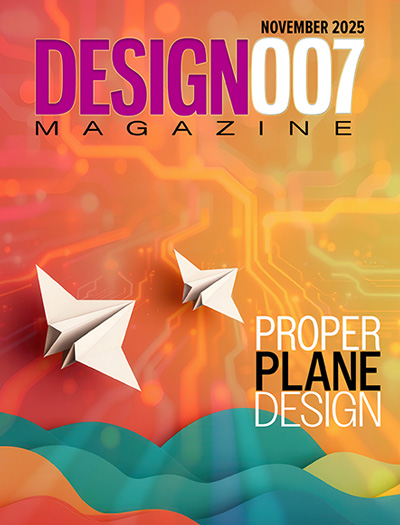-

- News
- Books
Featured Books
- design007 Magazine
Latest Issues
Current Issue
Designing Proper Planes
Without planes, designers would have to create thousands of traces to accomplish the same objectives. Power planes provide low impedance and stable power, and ground planes stabilize reference voltage, improve thermal performance, and help preclude EMI issues.

Power Integrity
Current power demands are increasing, especially with AI, 5G, and EV chips. This month, our experts share “watt’s up” with power integrity, from planning and layout through measurement and manufacturing.

Signal Integrity
If you don’t have signal integrity problems now, you will eventually. This month, our expert contributors share a variety of SI techniques that can help designers avoid ground bounce, crosstalk, parasitic issues, and much more.
- Articles
- Columns
- Links
- Media kit
||| MENU - design007 Magazine
Automation and the Smart Factory: Introduction to Industry 4.0
May 13, 2019 | Happy Holden, I-Connect007Estimated reading time: 1 minute
There’s a lot of talk about automation, but I find that there is very little available on automation planning. This is one of my specialties. I started by studying for an MSEE in control theory, which went well with my bachelor’s degree in chemical engineering because I specialized in process control and IC manufacturing.
Before we get started, remember that the benefits will be derived only if certain cardinal principles are observed. This article briefly outlines the background of computer-integrated manufacturing (CIM) and its evolution to Industry 4.0 and smart factories.
The characteristics of successful automation application in manufacturing depend on how well business and technical management understand and promote the strategies, tactics, and philosophies used in modern manufacturing. Successful automation implementation can be enhanced in any company, small or large, by reviewing the philosophies of CIM, automation, management roles, mechanization, SPC, TQC, Lean, MRP, and DFM.
Computer-Integrated Manufacturing (CIM)
The strategies outlined here are considered CIM, but the current vocabulary now is “Industry 4.0” or “smart factories.” Products include various software, computer, networking, interface, and measurement systems. At that time, HP had been in the automation business longer than any other company. It all started with requests from the government and others for automated test and measurement systems. Because of the need to automate various measurement instruments and systems, HP created the first machine-to-machine, plug-and-play protocol called HP Interface Bus (HP-IB). This was later formalized into the IEEE-488 communication standard.
CIM architecture was defined as early as 1980 when the CASA/SME published a presentation of computer-integrated manufacturing to provide a common set of terms for its members. The ring surrounding the wheel represents various influencing factors for the development of CIM such as expertise as a human factor, productivity as an economic factor, and computer technology as a technological factor.
The wheel itself contains four functions, including engineering design, manufacturing planning, production control, and factory automation. If the individual functions are connected to each other and operate with a common database, an integrated system architecture is created and represented by the hub of the wheel. This development has resulted in the realization that CIM, apart from factory automation and functions, is indirectly related to the operational performance, such as design (product/process), and production planning and control.
To read this entire article, which appeared in the April 2019 issue of Design007 Magazine, click here.
Testimonial
"The I-Connect007 team is outstanding—kind, responsive, and a true marketing partner. Their design team created fresh, eye-catching ads, and their editorial support polished our content to let our brand shine. Thank you all! "
Sweeney Ng - CEE PCBSuggested Items
Flexible Circuit Technologies Welcomes Senior Applications Engineer Zack Schaner
11/18/2025 | Flexible Circuit TechnologiesFlexible Circuit Technologies a Minnesota-based flexible circuit and advanced electronics contract manufacturer, welcomes Zack Schaner as Senior Applications Engineer.
productronica Innovation Award 2025: The Winners Have Been Chosen
11/18/2025 | productronicaThe decision has been made in the productronica Innovation Award 2025. An independent jury has selected the best innovations from among 80 submissions in six categories.
SEMI Applauds Introduction of New Bill to Extend U.S. Tax Credit for Semiconductor
11/18/2025 | SEMISEMI, the industry association serving the global semiconductor and electronics design and manufacturing supply chain, announced support for the introduction of the Strengthening Essential Manufacturing and Industrial Investment Act (the SEMI Investment Act) in the United States House of Representatives.
Hummink Raises $20 Million to Bring Micronic Precision Printing to Advanced Manufacturing
11/18/2025 | Globe NewswireAs microelectronics underpin the rise of artificial intelligence and high-performance computing, the smallest manufacturing imperfections have become billion-euro problems.
Palladyne AI Establishes Vertically Integrated U.S. Defense Technology Pioneer Through Transformative Acquisitions
11/18/2025 | BUSINESS WIREPalladyne AI Corp., a developer of artificial intelligence software for autonomous platforms in the defense and commercial sectors, announced the acquisitions of GuideTech LLC., and two Crucis companies: Warnke Precision Machining and MKR Fabricatorsa.


